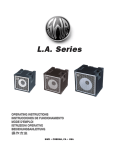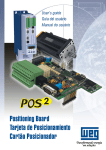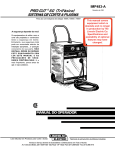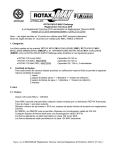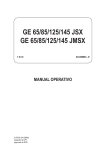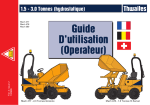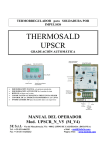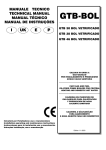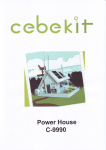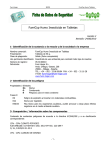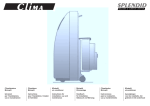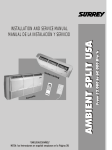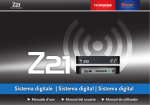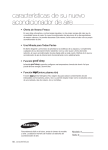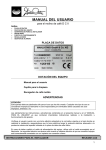Download Owner`s Guide Owner`s Guide Manual del Usuario
Transcript
Owner's Guide Guide Owner's Manual Instalación Manual del del Usuario Usuario ee Instalacion RC - R/B RQ - R/B Leer el manual antes de usar. Read the owner`s guide before using. It includes guarantee certificate Incluye certificado de garantia Nota: las instruciones en Español empiezan en la página 17 For future reference, fill in detail of your purchase below and keep this Owne's Guide in a safe place. Conserve el manual para futuras referencias. Congratulations! You made the perfect choice. You just acquired a world class technology product. Custumed in high resistance plastic for a longer lasting, lighter and more compact appliance. Which also avoids rusting problems. In this handbook, we will try to clarify all your doubts, from the installation premises election to the basic handle controls. ❋ CONTENTS - Installation instructions .................................................................................................... 3 - Electrical installation ........................................................................................................ 6 - Power suply ..................................................................................................................... 8 - Operating your air conditioning applicance ..................................................................... 10 - Care and maintenance of the appliance .......................................................................... 15 - Troubleshooting Guide ................................................................................................... 16 LIST OF SYMBOLS V - Volt - Ground A - Amps - Caution Hz - Hertz W - Watt - Risk of electric discharge Kg - Kilogram - Fuse Oz - Ounce in - in - Read the manual before using. IPXX - IP number ❋ IMPORTANT RECOMMENDATIONS - install your air conditioning unit facing the longest side of the chosen room. - the ideal installation height is 1.5 m up from the floor level. - in the event of installing a second air conditioning unit in the same room, avoid the proximity of the two appliances. -NEVER install your device behind curtains, furniture or dividers, because this may block the air flow of your appliance. 2 - Its better to install your appliance on the walls facing east or south, where solar incidence is weaker. - avoid using the cooling function of your appliance with indoors temperatures lower than 20 ºC, so ice may not be formed on the internal heat exchanger. - To avoid freezing of the external heat exchanger, do not use the heating function with outdoors temperatures lower than 4ºC. -WHENEVER you want to change from the cooling function to the warming function, or conversely, turn off the equipment and wait at least 2 minutes before turning it on again. - If electrical energy is interrupted, immediately turn your unit off and turn it on again just after 1 minute of the energy re-establishment. This procedure will avoid damage to the compressor due to tension variations. - Do not use the temperature control (thermostat knob) as a switch to turn on-off the equipment. The thermostat is the principal safety device of its electrical circuit. ❋ INSTALLATION INSTRUCTIONS INSTALLATION ON WALLS The opening in the wall must allow the perfect fit of a framework to fix the appliance, as well as to give a decorative finishing. Remember that the wooden beams of the framework must be of at least of 2.5 cm thick. You must have in mind that the wall you choose to install the unit on must be free of pillars, girders, pipelines and electrical ducts. According to the following table and the previous figure, chose the internal sizes of the framework: Dimensions A 48,5 cm B 33,5 cm 3 C(máx) 17 cm Build the framework, fixing the four parts. Put and fix the frame onto the wall through 6 fixing points (3 upside and 3 downside) INSTALLATION OF THE APPLIANCE - to detach the metallic base of the appliance, unscrew the safety screw located on the right hand side lateral part of the same. - join the two lateral beams to the base with a screw in each lateral. screw screw - fix the metallic set (base and beams) to the framework, with three screws at the base and two screws at each lateral beam NOTE: before resuming the installation, be sure that the slope of the base is 0.5 blister (1 cm). - slide the appliance on the metallic base all the way and put the safety screw located in the straight lateral part of the appliance back on. - arrange the restraining foam to the lateral and upper parts between the framework and the appliance to avoid air flow between the external and the internal environments. - fix the molding on the wall to finish the installation procedure. IMPORTANT 1) Once the installation ended, confirm the slope of the appliance is correct. 2) To reduce the cable length: - withdraw the plastic front by unscrewing the two screws located in the upper part of the appliance - adjust the cable length, arrange the remaining cable on the back of the control panel 4 - Put the plastic front back on by encasing first the lower part and then the upper part 3) The unit comes out of factory with the cable arranged on right hand side, but if you wish, it is possible to change it to the other side. To do this, withdraw the plastic front, pass the cable to the other side placing it in the lower part of the appliance, and clip the plastic front on the labeled place. 4) Your appliance has a drainage for water to exit. Depending on the place of installation, you may use a hose connected to the drainage net of your residence to avoid water dripping from occurring. drain 5) In order to keep a normal air flow through the compressor and condenser please verify that the lateral and superior openings of the appliance are turn outward and TOTALLY cleared. Otherwise, your appliance may present operation problems, with possible compressor failure. Very thick walls should be beveled outwardly. WALL INSTALLATION USING SPECIAL CONCRETE BOXES - follow all the previous instructions - verify if the slope of the appliance is correct (0,5 blister - 1 cm) - leave lateral and upper openings so the air flow within the compressor and the condenser is normal. INSTALLATION ON WINDOWS The installation on windows is recommended only in those cases in which there is not any possibility of installing the appliance on walls, since it can cause vibrations and noise. But, if it is the only place available, follow these suggestions: 5 - You must have a iron or steel reinforced structure, French hand type or loafer, duly measured for your appliance, similar dimensions to those for wall installation - Avoid all contact of the appliance with the glass panes, supporting it with rubber cradles to avoid vibrations and noise. ❋ ELECTRICAL INSTALLATION 1. All the wiring will have to comply with the local and national codes of electricity and it will have to be installed by qualified personnel. 2. There must be available an individual derived circuit with a proper outlet for the exclusive operation of this air conditioning appliance. Consult following table with information on the capacity suggested for the cables for the derived circuit. 3. It is essential that the outlet plug that you select matches the inlet plug of the appliance and it is within reaching distance of the installed appliance. NOTE: The inlet cord is 39 inches ( 991 mm) long and it is attached to the lower part of the command checkerboard. DO NOT USE a plug adapter nor an extension cord. Check Table 2 for information on types of plugs and fuses. 4. Comply with the fuse type (Table 2) indicated in the data plate of the appliance, located above the air discharge. 5. IMPORTANT: The wires in the principal cable are arranged according to the following colour code: Green and Yellow: Earth Blue: Neutral Brown: Phase Since the colors of the wires in the principal cable of this equipment could not correspond to the terminals identifying colours in the plug, proceed in the following way: ✓ the green and yellow wire must be connected to the terminal in the plug that it is labeled with the letter E (Earth) or by the earth symbol or coloured green and yellow. ✓ the blue wire must be connected to the terminal that it is labeled with the letter N or black coloured. ✓ the brown wire must be connected to the terminal that it is labeled with the letter L or coloured in red 6 MODELS RC-067- RC-097- RQ-097- RC-081- RC-051- RC-077- RQ-077- COOLING ONLY COOLING ONLY HEAT PUMP COOLING ONLY COOLING ONLY COOLING ONLY HEAT PUMP 220 V 1 PHASE - 50 HZ POWER SUPPLY LOCKED ROTOR CURRENT (NOTE 1) NOMINAL CONDITIONS * OPERATING ELETRIC DRAWS COOLING MAX. CONDITIONS ** NOMINAL CONDITIONS *** HEATING MAX. CONDITIONS **** OPERATING LIMITS MAIN SUPPLY DELAYED FUSES WIRE SIZE (NOTE 2) 22,8 A 15,0 A 6,5 4,5 4,5 W 1760 2490 N/A 22,8 2490 58,6 9,9 2345 42,2 10,5 1150 4,7 2050 4,7 2050 N/A N/A N/A N/A N/A N/A A 4,5 4,7 W __ 2050 __ 2050 A W __ A mm C TEMP. ROOM o C OUTSIDE o MINIMUM C TEMP. ROOM o C V N/A 2,5 2 o __ 15 A OUTSIDE __ N/A W MAXIMUM POWER SUPPLY 115V - 50HZ - 1 PHASE 220 V 1 PHASE - 50 HZ 43 43 24 d. b. 18 w. b. 32 d. b. 32 d. b. 23 w. b. 23 w. b. 27 19 19 5 21 d. b. 21 d. b. 15 w. b. 15 w. b. * NOMINAL CONDITIONS: TEMPERATURE CLIMATE 220 V - 1 PHASE - 50 HZ ISO 5151.2/T1 43 32 d. b. 32 d. b. 23 w. b. 23 w. b. 19 __ 198 min-264 máx. 43 19 21 d. b. 21 d. b. 15 w. b. 15 w. b. 104 min-127 MAX. 43 24 d. b. 18 w. b. 32 d. b. 23 w. b. 27 19 5 21 d. b. 15 w. b. __ 198 min-264 máx. *** NOMINAL CONDITIONS: 220 V - 1 PHASE - 50 HZ AHAM RAC-1 indoor: 21,1ºC dry bulb 15ºC wet bulb outdoor: 8,3ºC dry bulb 6,1ºC wet bulb indoor: 27ºC dry bulb 19ºC wet bulb outdoor: 35ºC dry bulb 24ºC wet bulb ** MAX. CONDITIONS: 198V - 1 PHASE 50 HZ ISO 5151.2/T1 **** MAX. CONDITIONS: 198V - 1 PHASE - 50HZ ISO 5151-2 indoor: 32ºC dry bulb 23ºC wet bulb outdoor: 43ºC dry bulb 24ºC wet bulb indoor: 27ºC outdoor: 24ºC dry bulb 18ºC wet bulb 7 ❋ POWER SUPPLY Always use thermomagnetic circuit breakers together with differential circuit breakers. The wiring shall comply according with the Standards for buildings. The nominal section of the power supply line conductors for the electric outlet shall comply with the directives of standards considering the nominal current, the total length until the power consumption point and the correction factors for cabling grouping shall be verified. Cable (mm2) 1,5 2,5 4,0 Max. Amps (A) 13 18 24 Recommended Fuse (A) 16 20 25 Values taken from the standard for cables in conduits. IMPORTANT: The conductors current capacity shall NEVER be less than the thermomagnetic circuit breaker capacity. It is not recommended to install two single-phase thermomagnetic circuit breakers in this case. Before plug in the equipment, check if the outlet polarity is the same as the one shown in the equipment data sheet. TABLE 2 RECEPTACLE AND FUSE TYPES 125 250 15 20 15 20 30 10 250 20 30 16 FUSE SIZE 15 20 20 30 15 TIME DELAY FUSE (or Circuit Breaker) Plug Plug RATED VOLTS AMPS WALL OUTLET 15 20 Cartridge 8 30 15 Used on Argentina only used on Europe GROUNDING All our units are manufactured according to the strictest safety requirements. To ensure a complete and effective protection to the user IT IS VERY IMPORTANT AND ESSENTIAL TO HAVE A PERFECT GROUNDING CONNECTION. Comply with the standards about the grounding connections for this type of equipment, even if the circuit has a differential circuit breaker for its additional protection. Use grounding conductors similar to the power supply cables with green or yellow insulation colors. IN NONE CIRCUNSTANCES the unit’s plug shall be removed by cutting the power supply cables, or a two-pin plug installed, and adapters shall not be used for plugging the unit. Use three-pin plugs only. NEVER connect the grounding cables to water distribution pipes. This action may cause a risk for you as well as for other people. THE UNIT SHALL BE PLUGGED IN ONLY AFTER YOU HAVE COMPLIED WITH ALL THESE REQUIREMENTS. 9 ❋ OPERATING YOUR AIR CONDITIONING APPLIANCE (FOR MECHANICAL UNITS ONLY) In order to get the best performance of your air conditioning unit is necessary for you to know how to operate the thermostat and the select functions knobs properly. Reading the following instructions you will understand easily how to operate your equipment. - always turn the select functions knob clockwise - turn the knob until desired position is reached-cooling (COOL) or heating (HEAT) - turn the thermostat knob to the maximum position for the chosen function - wait for the equipment to work raising or dropping room temperature - once you feel comfortable with the temperature reached turn slowly the thermostat knob in the opposite sense, towards the minimum position, until a click is heard - then turn the knob in the opposite sense, towards the maximum position, just a little. By following the previously described procedure you will be setting the equipment to maintain the current temperature which you find ideally comfortable. To turn off your air conditioning appliance its enough to turn the select function knob clockwise to the (MODE) OFF position. 10 ❋ OPERATING YOUR AIR CONDITIONING APPLIANCE (FOR REMOTE CONTROL UNITS ONLY) LIGA/DES LIGA/DES By pressing the key you turn your ELECTRONIC AIR CONDITIONING ON or OFF on the remote control. When you turn on the equipment, the LEDs on the electronic panel will display the information from the previous programming. When you turn it off, all LEDs turn off as well. When you change any setting on your remote control, the electronic panel on the inside unit will acknowledge the change with a "BEEP". Don't worry if you try to turn on the equipment again in less than 3 minutes and it does not respond immediately, as this is normal procedure controlled by an internal safety device on the compressor. FUNÇÃO AQUEC. REFRIG. VENT. AUTO By pressing the FUNCTION keys you can select the desired OPERATION MODE. AQUEC. On (HEAT)mode the equipment will raise the selected temperature between 18 and 29 ºC. When switching the OPAQUEC. ERATION MODE to (HEAT) the electronic controller will assume the last selected temperature. If this is not the lowers 11 convenient temperature, you can change the settings by + TEMP. using the TEMP. or keys. AQUEC. The (HEAT) mode is only available on units that operate both on cooling and heating. The activation of this mode will be acknowledged by a red LED on the electronic panel. REFRIG. On (COOL) mode the equipment will lower the selected temperature between 18 (64F) and 29 ºC (84F). When switching REFRIG. the OPERATION MODE to , (COOL) the electronic controller will assume the last selected temperature. If this is not the convenient + temperature, you can change the settings by using the or TEMP. TEMP. keys. The activation of this mode will be acknowledged by _ an orange LED on the electronic panel. VENT. On (FAN) mode, the equipment circulates the air by using the fan only, with no temperature change. The activation of this mode will be acknowledged by a green LED on the electronic panel. AUTO The mode keeps the temperature constant as monitored by the electronic controller, automatically switching between COOLING and HEATING and alsochanging the speed as necessary. When switching to AUTO the electronic controller will assume the last selected temperature. If this is not the convenient temperature, + TEMP. you can change the settings by using the TEMP. or _ keys. Once the electronic controller has selected an operation mode, it won't be changed in less than 30 minutes since the last mode switch, even if it is necessary, in order to protect the equipment. AUTO The option is only available on units that operate both on cooling and heating. The activation of this mode will be acknowledged simultaneously by an orange LED and a red LED on the electronic panel. + By pressing the TEMP keys, you perform the ppropriate TEMPERATURE SETTING for your convenience. + The key raises the temperature. The TEMP. key _ TEMP. TEMP. TEMP. - 12 28ºC 29ºC This option can be viewed on sis LEDs on the electronic panel, as shown on the table on the right: 26ºC 27ºC. ! Note: 23ºC 24ºC 25ºC • on VENT. (FAN) mode, the temperature LEDs will remain off. • the electronic panel will "BEEP" twice if the temperature range is exceeded. 22ºC BAIXA TEMP. 18ºC 19ºC 20ºC ALTA 21ºC VELOC. TIMER 2h 5h 8h By pressing the SPEED keys, you select the desired FAN SPEED. ALTA : HIGH: by pressing this key, your air conditioner will operate at top fan speed, regardless of temperature mode. BAIXA : LOW: by pressing this key, you air conditioner will operate at minimun fan speed, regardless of temperature mode. By pressing the "TIMER" keys you can set the unit's operation time until it is automatically turned off. You can choose between: 2h : 2h - by pressing this key once, you set the equipment to turn5h off after two hours. : 5h - by pressing this key once, you set the equipment to turn8h off after five hours. : 8h - by pressing this key once, you set the equipment to turn off after eight hours. These settings will be acknowledged by a yellow LED on the electronic panel. To change the equipment's operation time, just press the key for the newly desired selection. Just bear in mind that, by performing this change, you will be canceling the previous setting and starting a new one, and the newly selected time will be counted from the moment of change. To cancel a program setting, just press the same key that was used to activate it. The canceling of the "TIMER" mode will be acknowledged by the turning off of the yellow LED on the electronic panel. 13 BASIC PROCEDURE REPLACING THE REMOTE CONTROL BATTERIES The remote control of you ELECTRONIC AIR CONDITIONING uses two AA 1,5 V batteries. Never use old batteries or any type other than the specified one and keep in mind that the average lasting time of a battery is 1 (one) year. Do not replace batteries while the equipment is on. Remove the cover of the battery chamber on the upper part of the remote control and replace them. Test them by turning off the equipment. If it doesn't work, remove the batteries and repeat the operation. EMERGENCY MODE This mode shoud only be used to activate the equipment in case of dead batteries on the remote control or loss or damage of the remote control. The EMERGENCY MODE is actvated by an inside button on the electronic panel, as shown on the left. Use a pointed object to activate the button (A). By pressing the button once, the equipment will operate on: (A) COOLING on cooling-only units AUTO: on units that operate both on cooling heating On both cases, the equipmente will assume 23 ºC (73F) as the convenient temperature. By pressing the button once again, the equipmente will turn off. REMOTE CONTROL POSITIONING • The remote control can be used at a maximum distance of 7 meters from the equipment. • Getting sounds: The "BEEP" will be heard in the following cases, indicating that a command was accepted: - on turning on - on turning off - on switching modes - on changing the temperature setting 14 DIRECTING THE AIR FLOW You can change the direction to which the air flows by moving the adjustable baffles on your unit. You can move them up, down, to the left or to the right. ❋ CARE AND MAINTENANCE OF THE APPLIANCE WARNING Before you clean the air conditioner br sure to turn off the circuit breaker or the power main switch. PLASTIC FRONT AND CABINET Clean the plastic front and the cabinet with a damp flannel or a soft cloth with warm water and neutral soap. Do not use steel sponges on the appliance because they may scratch the surface. NEVER use detergents, alcohol or water directly on the plastic front of the appliance. AIR FILTER Your air conditioning appliance has a filter that retains all the impurities of the air. The filter requires special care, to clean it follow de instructions: - before to start cleaning it, turn off it the appliance - to remove it, raise it using the two handles located under the air exhaust of your appliance. - vacuum clean or wash it with luke warm water and neutral soap. Flap and let dry well before putting it back on the appliance. - clean the filter every two weeks IMPORTANT - a dirty air filter means a reduced capacity of your air conditioning unit and an energy consumption increase. - NEVER operate your appliance without the air filter, since the dust and other solid particles may penetrate the components, and thus damaging your appliance. - for the models with heaters, it is advisable to turn on the heating once a month. - if the device is not going to be used in long time, turn off the main switch and unplug it. CABLES Verify periodically if the power supply cable or register are damaged, for safety do not use the unit. Before using the equipment again the power supply cable must be replaced by qualified personnel, manufacturer or specialized technical service. 15 ❋ TROUBLESHOOTING GUIDE Before calling a technician, see how to proceed if your air conditioning device presents some of the following described symptoms. TROUBLE The unit does not work The unit does not work properly PROBABLE CAUSE 1) The main switch turned off 2) Appliance is unplugged outlet 3) Energy failure SOLUTIONS 1) Turn main switch back on 2)Plug your unit to the electrical 1) Dirty air filter 2) Air flow is blocked 1) Clean the air fliter 2) Remove objects interfering with the air flow (curtains, furniture, ...) 3) Be sure all the doors and windows are well closed 4) Supress any heat source 5) Place the thermostat knob correctly according to this handbook 6) Chose a larger model to fulfill your needs 3) The room is not well closed 4) There is some heat source 5) Thermostat knob is not correctly placed 6)The device is under dimensioned for the premises Frozen internal heat exchanger 1) Unproper air flow 1) Move objects that may be blocking the air flow 2) Clean the air filter 2) Dirty air filter Water leaks within the room 3)Wait for the energy to come back 1) Clogged drainage 2) Improper installation 1) Unclogged the drainage 2)Install the unit properly according to this handbook 16 ¡Felicitaciones! Usted acaba de hacer una excelente elección. Usted adquirió un producto con tecnología mundial, producido en plástico de alta resistencia que permite más durabilidad, elimina problemas de oxidación y hace con que el aparato sea más liviano y compacto. En este manual, procuramos aclarar todas sus dudas, desde el lugar elegido para la instalación hasta el simple manejo de los controles. ❋ ÍNDICE - Instrucciones para instalación ........................................................................................ 18 - Instalación eléctrica ....................................................................................................... 21 - Alimentación eléctrica .................................................................................................... 23 - Operando su aparato de aire acondicionado ................................................................... 25 - Conservación y mantenimiento del aparato .................................................................... 31 - Soluciones prácticas ...................................................................................................... 32 LA LISTA DE SÍMBOLOS V - Volt A - Ampere Hz - Hertz W - Watt Kg - Kilogramo Oz - Onza in - Pulgada IPXX - Número IP - Tierra - Precaución - Riesgo de choque eléctrico - Fusible - Leer el manual antes de usar. ❋ RECOMENDACIONES IMPORTANTES - instale su aire acondicionado de frente para el una mayor dimensión del ambiente escogido. - la altura ideal para la instalación es de 1,5m arriba del nivel del piso. - en la instalación de un segundo aire acondicionado en un mismo ambiente, evite la proximidad de los dos aparatos. - JAMÁS obstruya la circulación de aire de su aparato, instalándolo atrás de cortinas, muebles o poneles divisorias. 17 - procure instalar su aparato en las paredes orientadas hacia el este o el sur, donde la incidencia solar es más débil. - evite el uso de este aparato en la operación de enfriamiento con temperaturas internas inferiores a 20 ºC para que no ocurra formación de hielo en el dispositivo de calor interno. - evite el uso de este aparato en la operación calentamiento con temperaturas externas inferiores a 4ºC, pues podrá ocurrir el congelamiento del dispositivo de calor externo. - SIEMPRE que quiera cambiar de la operación enfriamiento para calentamiento, o viceversa, apague el equipo y aguarde 2 minutos antes de encenderlo nuevamente. - si la energía eléctrica fue interrumpida, apague inmediatamente su aire acondicionado y solamente vuelva a encenderlo 1 minuto después del restablecimiento. Ese procedimiento evitará variaciones de tensión que pueden ocasionar que el compresor se queme. - no utilice el interruptor como llave de encendido-apagado del equipo. El interruptor es el principal dispositivo de seguridad de su circuito eléctrico. ❋ INSTRUCCIONES PARA INSTALACIÓN INSTALACIÓN EN PAREDES La abertura en la pared debe permitir el encaje perfecto de un marco para fines de acabado, bien como para fijar el aparato. Conviene recordar que el espesor de la madera del marco debe ser de por lo menos de 2,5 cm. Usted debe tener mucha atención cuando escoja el local en la pared. Él debe estar libre de pilares, vigas, tuberías y electroductos. De acuerdo con la tabla a seguir y la figura anterior, vea los tamaños internos del marco: Tamaño A 48,5 cm B 33,5 cm C (máx.) 17 cm 18 Arme el marco, fijando las cuatro partes. Coloque y fíjelo en la pared a través de los 6 puntos de fijación (3 arriba y 3 abajo). INSTALACIÓN DEL APARATO - para desprender la base metálica del aparato, retire el tornillo de seguridad localizado en la parte lateral derecha del mismo. - prenda los dos tirantes laterales en la base con un tornillo en cada lateral. tornillo tornillo traba moldura tornillo de seguridad 10 mm inclinación - fije el conjunto metálico (base y tirantes) en el marco, prendiéndolo y fijándolo con los tres tornillos de la parte inferior y los dos laterales NOTA: antes de continuar la instalación, observe si la inclinación de la base es de 0,5 ampolla (1 cm). - deslice el aparato sobre la base metálica hasta el fondo y coloque el tornillo de seguridad localizado en la parte lateral derecha del aparato - coloque la espuma de vedado en las laterales y parte superior entre el marco y el aparato para evitar el pasaje de aire del ambiente externo para el interno y viceversa - fije la moldura en la pared para dar el acabado en la instalación. IMPORTANTE 1) Terminada la instalación, observe si la inclinación del aparato está correcta. 2) Para disminuir la largura del cable: - retire la frente plástica a través de los dos tornillos localizados en la parte superior del aparato - ajuste el tamaño del cable, colocando la parte excedente atrás del panel de control - Coloque nuevamente la frente plástica encajando primero la parte inferior de la misma 19 3) El cable de su aparato sale de fábrica colocando al lado derecho, pero si usted lo desea, es posible cambiarlo de lado. Para esto, retire la frente plástica, pase el cable para el otro lado acomodándolo en la parte inferior del aparato, recorte la frente plástica en el local marcado. 4) Su aparato contiene un dreno para salida de agua. Dependiendo del local instalado, use una manguera conectada a la red de drenaje de su residencia evitando que ocurra goteo de agua en locales no apropiados. dreno interna pared externa abertura 92cm 5) Para que el movimiento del aire en el compresor y condensador se procese normalmente, verifique atentamente si las aberturas laterales y superior del aparato están volcadas para fuera y TOTALMENTE desobstruidas. Caso contrario, su aparato corre el riesgo de presentar problemas en el funcionamiento, con posibilidad de que el compresor se queme. Paredes muy espesas deben ser chaflanadas exteriormente. INSTALACIONES EN PAREDES CON EL USO DE CAJAS ESPECIALES DE CONCRETO - siga todas as instrucciones anteriores - verifique si la inclinación del aparato está correcta (0,5 ampolla 1cm) - deje aberturas laterales y superior para que el movimiento del aire en el compresor y en el condensador se procese normalmente. INSTALACIÓN EN VENTANAS La instalación en ventanas sólo se recomienda en casos en los cuales no exista la posibilidad de instalar el aparato en paredes, pues puede provocar vibraciones y ruidos. Pero, si es el único local disponible para la instalación, siga algunas sugerencias: - disponga de una estructura reforzada en fierro o acero, tipo mano francesa o cantonera, debidamente medida para su aparato para que se la fije en le pared - intente evitar al máximo el contacto del aparato con los vidrios, apoyándolo con cuñas de goma para evitar vibraciones y ruido. 20 ❋ INSTALACIÓN ELÉCTRICA 1.Todo el alambrado deberá cumplir con las normas locales y nacionales de electricidad y deberá ser instalado por electricistas calificados y con experiencia. 2.Deberá haber disponible un circuito independiente con su enchufe destinado exclusivamente para la operación de este aparato de aire acondicionado. Consulte la siguiente tabla con informaciones sobre la capacidad sugerida para los cables del circuito independiente. 3.Es esencial que el enchufe que usted seleccione corresponda al enchufe de alimentación del aparato y esté al alcance del aparato instalado. NOTA: El cordón de alimentación mide __ pulgadas ( ____ mm) d e largo y se extiende desde la parte inferior del tablero de mando. NO USE un adaptador de enchufe ni un cordón de extensión. Consulte la Tabla 2 para tipos de enchufes e información de fusibles. 4.Cumpla con las indicaciones de fusible (Tabla 2) indicadas en la placa de datos del aparato, localizado encima de la sección de salida de aire. 5.IMPORTANTE: Los alambres en este cable principal tienen colores de acuerdo con el siguiente código: Verde y Amarillo: Tierra Azul: Neutro Marrón: Fase Como los colores de los alambres en el cable principal de este equipo pueden no corresponder a las marcas de colores identificando los terminales en su enchufe, proceda de la siguiente manera: ✓ el alambre que está pintado de verde y amarillo debe ser conectado al terminal en el enchufe que está marcado con la letra E (Earth/ Tierra) o por el símbolo tierra o pintado de verde y amarillo. ✓ el alambre que está pintado de azul debe estar conectado al terminal que está marcado con la letra N o pintado de negro. ✓ el alambre que está pintado de marrón debe estar conectado al terminal que está marcado con la letra L o pintado de rojo. 21 MODELOS RC-067- RC-097- RQ-097- ALIMENTACIÓN ELÉCTRICA 220 V 1 PHASE - 50 HZ TRACCIÓN DE POTENCIA DE FUNCIONAMIENTO CORRIENTE DE ARRANQUE (NOTA 1) CONDIC. NOMINALES * ENFRIAMIENTO MAX. CODICIONES ** CONDIC. NOMINALES *** CALEFACCIÓN MAX. CODICIONES **** FUSIBLES RETARDADO LÍMITES DE FUNCIONAMIENTO CALIBRE DE LOS CONDUCTORES (NOTA 2) TEMPERATURA EXTERIOR MÁXIMA INTERIOR MINIMUM EXTERIOR TEMP. INTERIOR ALIMENTACIÓN ELÉCTRICA FRÍO SOLO FRÍO SOLO BOMBA DE CALOR 15,0 A RC-081- RC-051- RC-077- RQ-077FRÍO SOLO FRÍO SOLO 115V - 50HZ - 1 PHASE 22,8 FRÍO SOLO BOMBA DE CALOR 220 V 1 PHASE - 50 HZ 22,8 42,2 10,5 1150 4,7 2050 4,7 2050 N/A N/A N/A __ A 6,5 4,5 4,5 W 1760 2490 2490 58,6 9,9 2345 N/A N/A N/A N/A 4,5 4,7 __ 2050 2050 A W A W __ A W mm o C o C o C V N/A 2,5 2 C __ 15 A o __ N/A 43 43 24 d. b. 18 w. b. 32 d. b. 32 d. b. 23 w. b. 23 w. b. 19 27 19 __ 198 min-264 máx. 43 43 24 d. b. 18 w. b. 32 d. b. 32 d. b. 32 d. b. 23 w. b. 23 w. b. 23 w. b. 19 5 21 d. b. 21 d. b. 15 w. b. 15 w. b. 43 19 19 21 d. b. 21 d. b. 21 d. b. 15 w. b. 15 w. b. 15 w. b. 104 min-127 MAX. 27 5 __ 198 min-264 máx. (*) Condiciones Nominales (***) Condiciones Nominales CLIMAS TEMPLADOS 220 V - 1 fase - 50Hz 220 V – 1 fase – 50Hz AHAM RAC-1 ISO 5152.1/T1 interior: 21,1ºC bulbo seco 15ºC bulbo húmedo exterior: 8,3ºC bulbo seco 6,1ºC bulbo húmedo interior: 27 ºC bulbo seco 19 ºC bulbo húmedo exterior: 35 ºC bulbo seco 24 ºC bulbo húmedo (**) Condiciones Máx. (****)Condiciones Máx. CLIMAS TEMPLADOS 198V - 1 fase - 50Hz 198V – 1 fase – 50Hz ISO 5151-2 ISO 5152.1/T1 interior: 27ºC interior: 32 ºC bulbo seco 23 ºC bulbo húmedo exterior: 24ºC bulbo seco 18ºC bulbo húmedo exterior: 43 ºC bulbo seco 24 ºC bulbo húmedo 22 ❋ ALIMENTACIÓN ELÉCTRICA Utilice siempre interruptores termomagnéticos en conjunto con interruptores diferenciales. La instalación debe realizarse acorde a lo establecido por la Reglamentación para la Ejecución de Instalaciones Eléctricas en Inmuebles. La sección nominal de los conductores de la línea de alimentación hasta el tomacorriente deben obedecer a lo indicado por las normas, considerándose la corriente nominal, la distancia al punto de consumo y los factores de corrección para agrupación de cables. Cable (mm2) 1,5 2,5 4,0 Corriente Máxima (A) 13 18 24 Interruptor Termomagnetico 16 20 25 Valores extraídos de la norma para cables instalados en cañerías. IMPORTANTE: NUNCA utilice conductores cuya capacidad sea inferior a la capacidad nominal del interruptor termomagnético. No es recomendable el uso de dos interruptores termomagnéticos monopolares para esta aplicación. Antes de conectar el equipo cerciórese que la polaridad de su tomacorriente sea igual a la indicada en la ficha eléctrica del equipo. 23 INSTALACIÓN DE TIERRA Todas nuestras unidades están fabricadas con las más estrictas normas de seguridad. Para que la protección total del usuario sea efectiva ES IMPRESCINDIBLE PROVEER UNA PERFECTA CONEXION A TIERRA. Cumpla con el requerimiento legal que obliga a realizar la conexión a tierra de este tipo de aparatos, aún contando con la protección adicional de un disyuntor diferencial. Utilice conductores de tierra de sección igual a los cables de alimentación con aislación color verde/amarillo.. BAJO NINGUNA CIRCUNSTANCIA puede cambiarse la ficha de la unidad cortando el cable de alimentación, ni utilizarse tomacorriente de 2 bornes o adaptadores para la conexión a la red. Utilice solamente tomacorriente con 3 bornes. NUNCA asegure la continuidad de la toma de tierra con la cañería de la red de agua; ésto coloca en riesgo su seguridad o la de terceros. SI CUMPLIO CON TODOS ESTOS REQUISITOS, CONECTE LA UNIDAD TABLA 2 TIPOS DE TOMACORRIENTES Y FUSIBLES VOLTIOS NOMINALES AMPERIOS 125 250 250 15 20 15 20 30 10 20 30 16 15 20 15 20 30 15 20 30 15 TOMACORRIENTE CAPACIDAD DE FUSIBLE FUSIBLE CON RETARDO (o interruptor de Circuito) Enchufe Enchufe Cartucho 24 Para aplicaciones en la Argentina solamente Aplicacion en la Europe ❋ OPERANDO SU APARATO DE AIRE ACONDICIONADO (SÓLO PARA LOS APARATOS MECANICOS) Para que usted obtenga el mejor desempeño de su aparato de aire acondicionado es necesario saber colocar correctamente el botón del termostato y el botón del selector de operaciones. A través de la lectura de las instrucciones descritas abajo usted entenderá fácilmente cómo operar su equipo. - gire siempre el botón selector de operaciones (MODE) en el sentido horario - coloque el mismo en la operación deseadaenfriamiento (COOL) o calentamiento (HEAT). - gire el botón del termostato colocándolo en su posición máxima para la operación escogida - aguarde que el equipo climatice su ambiente - al sentir que la temperatura en el ambiente alcanzó la temperatura de comodidad deseada, diríjase hasta el equipo y gire lentamente el botón del termostato en dirección a su posición mínima hasta que usted escuche un pequeño “click” - ejecute entonces un leve giro en el sentido contrario Para apagar su aparato de aire acondicionado basta girar el botón del selector de operaciones en el sentido horario basta colocar el mesmo em apagar ( MODE OFF) 25 ❋ OPERANDO SU APARATO DE AIRE ACONDICIONADO (SÓLO PARA LOS APARATOS ELECTRÓNICOS) LIGA/DES LIGA/DES Presione la tecla usted ENCIENDE Y APAGA su AIRE ACONDICIONADO ELETRÓNICO a través del control remoto. Al enceder el equipo aparecerá en el panel electrónico, a través de los LED's, la totalidad de las informaciones contenidas en la programación anterior. Al pagarlo, todos los LED's se apagarán. Al cambiar cualquier parámetro a través de su control remoto el panel electrónico localizado en la unidad interna responderá al comando emitiendo un "BEEP" indicando que recibió la información. No se extrañe si, al intentar encender nuevamente antes de que hayan pasado 3 minutos, no hay respuesta inmediata del equipo, pues se trata de un procedimiento normal operado por dispositivo interno de protección del compresor. 26 FUNÇÃO AQUEC. REFRIG. VENT. AUTO Presionando las teclas del grupo FUNCIÓN (FUNÇÃO) usted opta por la OPERACIÓN DESEADA. AQUEC. En la función (CALENTAMIENTO) el equipo, cuando está en funcionamiento eleva la temperatura que usted ha establecido entre 18 ºC (64F) y 29ºC (84F). Al cambiar la AQUEC. OPERACIÓN DESEADA por (CALIENTAMIENTO) el controlador electrónico asumirá la última temperatura que usted haya establecido. Caso esta no sea la temperatura ideal para su comodidad, proceda al ajuste de la + TEMP. temperatura. Para tanto, utilice las teclas TEMP. o - . AQUEC. La opción (CALIENTAMIENTO) solamente está disponible en unidades que operen en enfriamiento y calentamiento. La confirmación del accionamiento de esta función se dará a través del LED rojo en el panel electrónico. REFRIG. En la función (ENFRIAMIENTO) el equipo, cuando está en funcionamiento, reduce la temperatura que usted ha establecido entre 18ºC (64F) y 29ºC (84F). Al cambiar la REFRIG. OPERACIÓN DESEADA por (ENFRIAMIENTO) el controlador electrónico asumirá la última temperatura que usted haya establecido. Caso esta no sea la temperatura ideal para su comodidad, proceda al ajuste de temperatura. Pra + TEMP. tanto, utilice las teclas TEMP. o _ . La confirmación del accionamiento de estas funciones se dará a través del LED anaranjado en el panel electrónico. VENT. En la función (VENTILACIÓN) el equipo fuerza la circulación del aire del ambiente permaneciendo en funcionamiento apenas el ventilador del mismo, sin alteración de la temperatura. La confirmación del accionamiento de esta función se dará a través del LED verde en el panel electrónico. AUTO La función consiste en mantener la temperatura del ambiente acondicionado siempre constante a través de monitoreo por el controlador electrónico de la unidad dando al mismo libertad de opción entre las funciones de ENFRIAMIENTO o CALENTAMIENTO, buscando también la velocidad de funcionamiento más adecuada para tal. Al AUTO cambiar para la función el controlador electrónico 27 + TEMP. - ! Presionando las teclas del grupo TEMP. usted ejecuta el AJUSTE DE TEMPERATURA propio para su comodidad. + A través de la tecla TEMP usted está elevando la temperatura TEMP. del ambiente. A través de la tecla _ usted está reduciendo la temperatura del ambiente. Esta opción está visible en el panel electrónico a través de 6 LED's, conforme la tabla al lado: 18ºC 19ºC 20ºC 21ºC 22ºC 23ºC 24ºC 25ºC 26ºC 27ºC. 28ºC 29ºC TEMP. asumirá la última temperatura que usted haya establecido. Caso no sea la temperatura ideal para su comodidad, proceda al ajuste de la temperatura. Para tanto utilice las + TEMP. teclas TEMP o _ . Después que el controlador electrónico defina por una de las funciones, aunque se verifique la necesidad de cambio de la misma, esta sólo se efectuará 30 minutos después de la última alteración, a fin de proteger el equipo. La opción AUTO solamente está disponible en unidades que operen en enfiamiento y calentamiento. La confirmación del accionamiento de esta función se dará a través de los LEDs anaranjado y rojo actuando simultáneamente en el panel electrónico. VELOC. Observación: VENT. • Operando en la función (VENTILACIÓN) los LED's referentes a temperatura permanecerán apagados. • El panel electrónico emitirá "BEEPs" caso el range de temperatura sea traspasada. TEMP. ALTA BAIXA Presionando las teclas del grupo VELOCIDADE (SPEED) Usted selecciona la VELOCIDAD DE VENTILACIÓN deseada. ALTA : ALTA: presionando una vez esta tecla, su acondicionador de aire operará en la velocidad máxima de insuflación de aire, independiente e la función escogida. BAIXA : BAJA: presionando una vez esta tecla, su acondicionador de aire operará en la velocidad mínima de insuflación de aire, independiente e la función escogida. Presionando las teclas del grupo TIEMPO (TIMER) usted define el tiempo de funcionamiento de la unidad hasta que esta se apague automáticamente. Usted puede optar por: 28 TIMER 2h 5h 8h 2h : 2h - presionando una vez esta tecla, usted estará informando al equipo que este deberá apagarse al final de dos horas de funcionamiento. 5h : 5h - presionado una vez esta tecla, usted estará informando al equipo que este deberá apagarse al final de cinco horas de funcionamiento. 8h : 8h - presionando una vez esta tecla, usted estará informando al equipo que este deberá apagarse al final de ocho horas de funcionamiento. La confirmación del accionamiento de esta función, se dará a través del LED amarillo en el panel electrónico. Para alterar el tiempo de funcionamiento del equipo, basta presionar la tecla del nuevo horario desado. Recuerde que, haciendo esta alteración, usted estará cancelando la programación anterior e iniciando una nueva, o sea, el nuevo tiempo de funcionamiento se contará a partir del momento de la altración. Para cancelar un comando de programación, basta presionar una vez la misma tecla usada para accionarlo. La confirmación del cancelamiento de la función TIMER se dará cuando el LED amarillo del panel electrónico se apague. PROCEDIMIENTOS BÁSICOS SUSTITUYENDO LAS PILAS DEL CONTROL REMOTO El control remoto de su AIRE ACONDICIONADO ELECTRÓNICO utiliza 2 (dos) pilas tipo AA 1,5V. Jamás utilice pilas usadas u otras que no las especifiadas y recuerde que la duración promedio de una pila para esta aplicación es de aproximadamente 1(un) año. No realice la sustitución de las pilas con el equipo encendido. Remueva las pilas en la parte superior del control remoto y opere la sustituición de las mismas. Haga la prueba encendiendo el aparato. En el caso de que no funciones retire las pilas y reinicie toda la operación. 29 MODO EMERGENCIA Este modo solamente debe usarse para accionar el equipo en caso de que las pilas del control remoto estén descargadas o entonces en caso de pérdida o daño del mismo. EL MODO EMERGENCIA se acciona a través de un botón interno localizado en el panel electrónico, conforme la figura anexa. Para accionar el botón, utilice un objeto puntiagudo. (A) Apretando el botón (A) 1 (una) vez el equipo pasará a funcionar en la función: REFRIG.: en los aparatos que operan apenas en enfriamiento AUTO: en los aparatos que operan en calentamiento y enfriamiento En ambas situaciones el equipo asumirá como temperatura ideal para funcionamiento 237ºC (73F). Apretando el botón nuevamente 1 (una vez), el equipo se apagará. POSICIÓN DEL CONTROL REMOTO • El control remoto puede ser usado a una distancia máxima de hasta 7 metros del equipo. • Recibiendo señales sonoras: La señal de "BEEP" del equipo podrá ser escuchada en los siguientes casos, indicando la recepción de la señal: - al ecender - al apagar - al cambiar de operación - al proceder a un nuevo ajuste de temperatura 30 DIRECCIÓN DEL AIRE Su aparato de aire acondicionado permite dirigir el aire para arriba, para abajo, para la izquierda o para la derecha a través de los deflectores regulables. ❋ CONSERVACIÓN Y MANTENIMIENTO DEL APARATO ADVERTÊNCIA Antes de limpiar el acondiconador de aire, apague el disyuntor o el interruptor principal. FRENTE PLÁSTICA Y GABINETE Haga una limpieza periódica en la frente plástica y en el gabinete con una franela o un pedazo de tela suave mojada con agua tibia y jabón neutro. No utilice esponjas de acero en la limpieza de su aparato pues ellas arañan el mismo. JAMÁS use detergentes, alcohol o agua directamente sobre la frente plástica del aparato. FILTRO DE AIRE Su aparato de aire acondicionado tiene un filtro que retiene las impurezas del aire del ambiente. Él requiere cuidados especiales para limpieza, como sigue: - antes de limpiarlo apague el aparato - para retirarlo, levántelo con las agarraderas localizadas debajo de la salida de aire de su aparato. - límpielo con aspirador de polvo o con agua tibia y jabón neutro. Sacuda y seque bien antes de colocarlo nuevamente en el aparato. - esta limpieza debe hacerse quincenalmente IMPORTANTE - filtro de aire obstruido representa la reducción de la capacidad de su aire acondicionado y el aumento del consumo de energía. - NUNCA opere su aparato sin el filtro de aire, pues el polvo e impurezas se instalarán en otros componentes, dañando su aparato. - es aconsejable encender los aparatos modelo caliente/frío en el calentamiento por algunos minutos de 30 en 30 días. - si no se utiliza su aire acondicionado por un período de tiempo más largo, desconecte o enchufe y apague el interruptor. CABLES Verifique periódicamente si el cable electrico de alimentacion y su ficha no se encuentren dañado, por seguridad no utilice el aparato. Antes de volver a utilizar el equipo el cable de alimentacion debe ser reemplazado por personal calificado, fabricante o servicio técnico especializado. 31 ❋ SOLUCIONES PRÁCTICAS Antes de llamar un técnico, vea cómo proceder si su aire acondicionado presenta alguno de los síntomas abajo descritos. PROBLEMA El aire acondicionado no funciona Equipo no acondiciona adecuadamente PROBABLES CAUSAS 1) interruptor apagado 2) cable de alimentación desconectado de la redeléctrica 3) falta de energía en la red 1) filtro de aire sucio 2) obstrucción del flujo de aire 3) ambiente abierto 4) existencia de alguna fuente de calor en el ambiente 5) botón del termostato mal colocado 6) el aparato no fue adecuadamente medido para el ambiente Dispositivo de calor interno congelado 1) circulación ineficaz del aire Flujo de agua para dentro del ambiente 1) drenage tapado 2) instalación incorrecta 2) filtro de aire sucio SOLUCIONES 1) encienda nuevamente el interruptor 2) conecte el cable de alimentación en el enchufe 3) aguarde el restablecimiento de la energía 1) limpie el filtro de aire 2) remueva las obstrucciones (cortinas, sofás, ...) 3) cierre las puertas o ventanas abiertas 4) elimine la fuente de calor del ambiente 5) ajuste correctamente la posición del termostato conforme instrucciones de este manual 6) defina adecuadamente, de nuevo, el modelo del aparato para el ambiente 1) desobstruya la frente del aparato 2) limpie o filtro de aire 1) desobstruya el drenage 2) corrija la instalación conforme instrucciones de este manual 32 SCHEMATIC REFRIGERATION SYSTEM/SISTEMA Cooling only unit / Unidades sólo refrigeración DE REFRIGERACIÓN 1. Outdoor unit coil Fico 2. Indoor unit coil Fico Gas Fico Liquid + Gas Líquido + Gas Liquid Líquido Refrigerante charge control Control de la carga refrigerante Heat pump unit/Unidad de bomba de calor 1. Outdoor unit coil Serpentín unidad exterior COOLING CYCLE Refrigerant charge control CICLO REFRIGERACION Control de la carga refrigerante 2. Indoor unit coil Serpentín unidad interior Gas Gas Liquid + Gas Líquido + Gas HEATING CYCLE Refrigerant charge control CICLO CALEFFACION Control de la carga refrigerante Liquid Líquido 33 WIRING DIAGRAM / CONEXIONES ELECTRICAS MECHANICAL UNITS / APARATOS MECANICOS RC MODELS / MODELOS RQ MODELS / MODELOS 34 WIRING DIAGRAM / CONEXIONES ELECTRICAS ELETRONIC UNITS / APARATOS ELETRÓNICOS RC MODELS / MODELOS RQ MODELS / MODELOS 35 36 37 38 GARANTIA Garantia válida solamente para el territorio de la República Argentina 39 Av. Remedios de Escalada 2900 B 1822AAP - V. Alsina - Lanús O. Buenos Aires - Argentina TEL.: (011) 4229 - 5085 WE AREN'T COMFORTABLE UNTIL YOU ARE NO ESTAMOS A GUSTO HASTA QUE USTED LO ESTÉ Manufacturer reserves the right to discontinue, or change at any time, specifications or designs without notice and wihout incurring obligations. El fabricante se reserva el derecho de descontinuar o cambiar en cualquer momento, las especificaciones o disños sin informar o sin incurrir en obrigaciones. 256.08.483 - A - 08/01









































